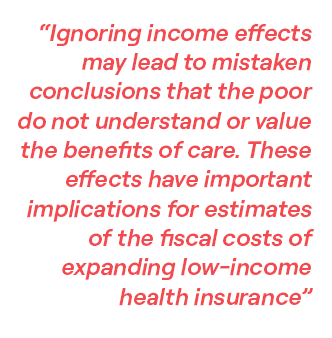How can policymakers ensure access to high-quality, affordable health care for all citizens? Research at the TSE Health Center aims to help public and private organizations achieve this goal. As part of this initiative, a recent paper by TSE’s Angelique Acquatella provides new insights explaining why low-income individuals may respond differently to health insurance subsidies than their higher-income counterparts, with important implications for research on health care demand and the effectiveness of subsidies.
What is puzzling about the use of health care services by low-income individuals?
While low-income individuals are typically the most price-sensitive segment of the market, this does not hold true in the market for health care services. Low-income individuals are less responsive to health care subsidies and use fewer health care resources than their higher-income counterparts, despite having worse health, on average. Potential explanations to these empirical patterns could include that either health insurance has little value for low-income individuals (as measured by their willingness to pay for insurance), that behavioral biases are particularly acute among low-income populations, or that accessing health care providers is more difficult for lower-income individuals who might live farther away from hospitals and health centers. While all of these explanations are likely contributing to lower utilization patterns among the low-income population, a key component of health care consumption decisions involves the trade-off between the (perceived) benefits of care against the costs of forgoing other forms of consumption, and the costs of forgoing other consumption are very different across the rich and poor.
Empirically, I reexamine data from the RAND Health Insurance Experiment – a large-scale field experiment from the 1970s which randomly assigned individuals to health insurance plans. I find that low-income individuals appear less responsive to prices, on average, because a disproportionate share consume zero health care (even when it is free). The RAND experimental setting is especially appealing because individuals chosen for the experiment came from metropolitan areas with similar proximity to health care facilities across high- and low-income individuals. Why might low-income individuals choose to consume no health care? I provide a simple theoretical framework to help explain this.
Which tradeoffs do you identify that may explain this puzzle?
Consider a low-income individual with chronic back pain. She may well understand that physical therapy would be beneficial for her, but she may not be willing to forgo making her monthly rent payment in order to go to the doctor. She would optimally choose to consume no care, neither because she misunderstands or misperceives the benefits of care, nor because the clinic is particularly far away or inconvenient to access, but rather because giving up resources is very costly at her low levels of income. While the notion of ‘income effects’ has been central to economic theory, the key insight in applying them to health care demand is that the choice to consume no health care could be optimal for a low-income individual, but perhaps not socially desirable.
Even as health insurance becomes more generous, the trade-off for low-income individuals may remain unchanged. Even as care becomes nominally free, the associated hassle costs – such as parking, taking the bus, taking time off from work, or scheduling the appointment – might be scaled up by the costs of forgoing non-health consumption because their opportunity costs of using health care are not merely a function of their wages, but also of their incremental value of non-health consumption, which is inversely related to income. This implies that some low-income individuals may optimally choose no health care, even when the price is zero.
What are the key contributions of your paper?
The costs of forgoing consumption are an important part of the story if we aim to understand differences in health care utilization across high- and low-income individuals. Moreover, if societal values aim to provide individuals with some basic level of health, relying on ‘demand side’ incentives that involve incentivizing individual patients to use health care may not be the most effective policy strategy.  This is because demand-side incentives seem to only work as intended for middle- and higher-income individuals, at least based on empirical evidence. Ignoring income effects may lead us to mistake empirical patterns for evidence that the poor do not understand or value the benefits of care. These effects have important implications for estimates of the fiscal costs of expanding low-income health insurance: if low-income individuals are unresponsive to demand-side incentives, the effects on insurance expenditures will consequently be small.
This is because demand-side incentives seem to only work as intended for middle- and higher-income individuals, at least based on empirical evidence. Ignoring income effects may lead us to mistake empirical patterns for evidence that the poor do not understand or value the benefits of care. These effects have important implications for estimates of the fiscal costs of expanding low-income health insurance: if low-income individuals are unresponsive to demand-side incentives, the effects on insurance expenditures will consequently be small.
But perhaps the more important implication is that policy objectives that aim to increase health equity might be more effective if targeted towards health care suppliers, as opposed to patients. Encouraging hospitals and health centers to establish facilities in lower-income neighborhoods, facilitating transportation and access to health care facilities, and providing greater information about how to access health care providers might be better at ensuring that individuals receive health care when they need it, relative to an alternative policy strategy that merely reduces the out-of-pocket costs of health care while leaving these other barriers unchanged.
What are the challenges for further empirical research in this area?
The main challenge to isolate the importance of income effects in health care demand is that income is related to many factors that could affect the choice of health care. Establishing the causal effect of out-of-pocket price changes on health care utilization across the income distribution is thus a challenging empirical exercise, and it is difficult to find empirical settings where the prices of health care change exogenously. Moreover, even in the case of the RAND experiment, it is difficult to separately identify income effects from behavioral biases, and these may have different implications for optimal insurance design. Empirical work generally accounts for income effects within the context of health insurance demand, but largely ignores them in the context of health care demand, with one notable exception (Finkelstein, Hendren, and Luttmer, 2019). If income effects are present in the choice of insurance, then they must also be accounted for in the choice of health care consumption. Finkelstein, Hendren, and Luttmer (2019) provide a method that can be used in future empirical work.
FURTHER READING
‘The Demand Elasticity of Health Care Spending for Low-Income Individuals’ and other publications by Angelique are available to read on the TSE website. See also Finkelstein et al (2019) on ‘The Value of Medicaid’.
Article published in TSE Reflect, November 2023





